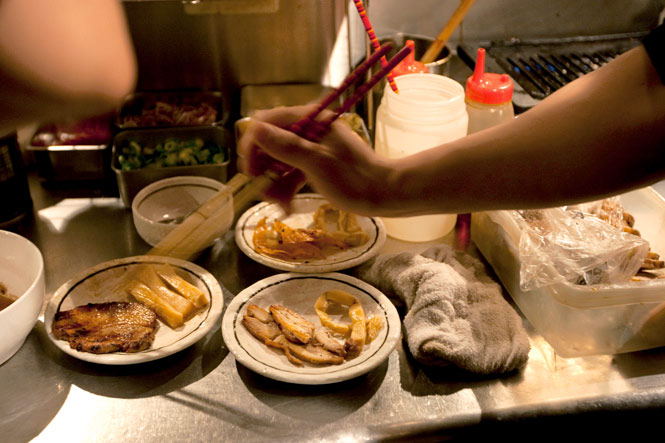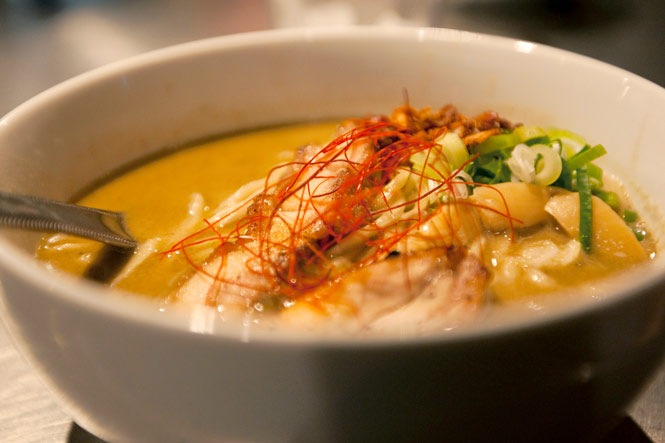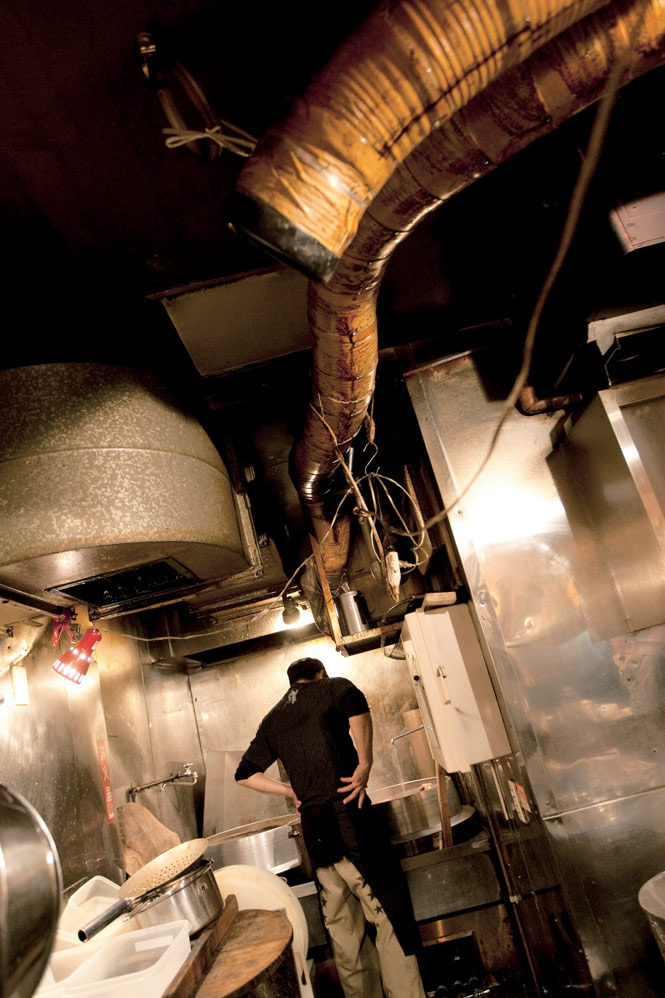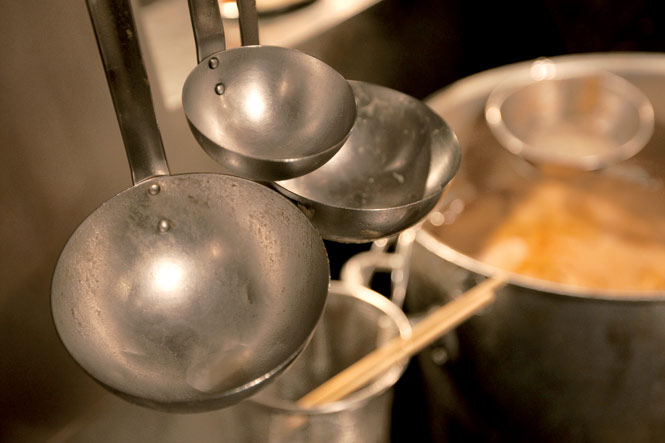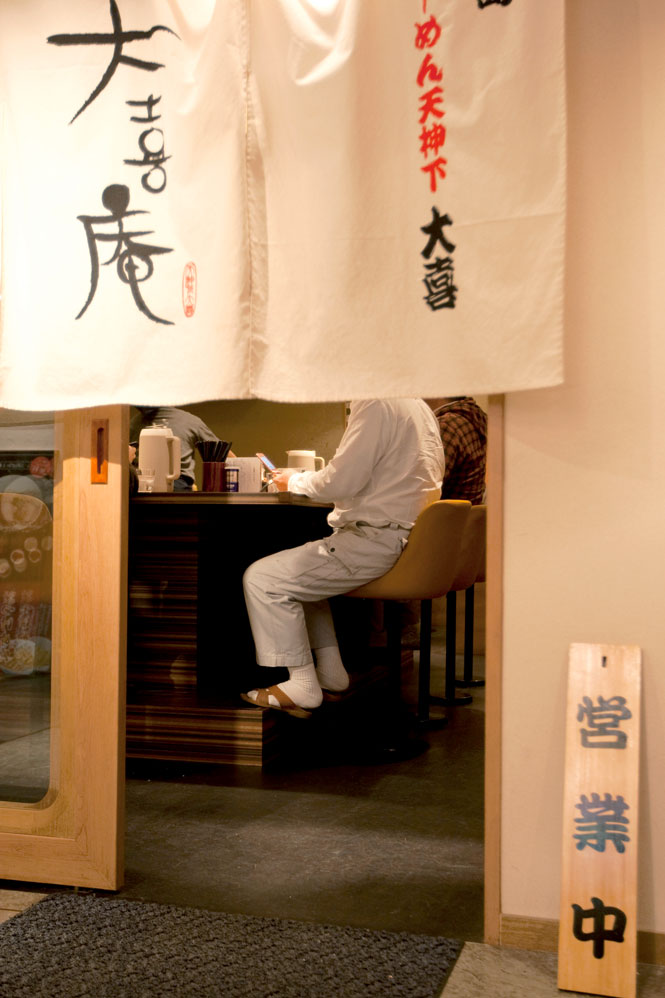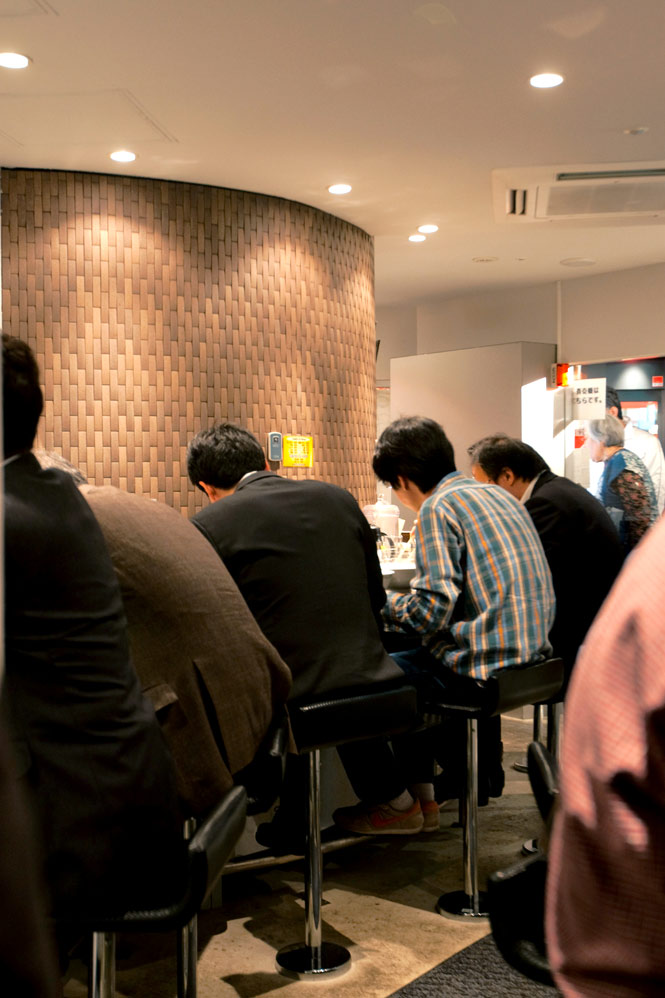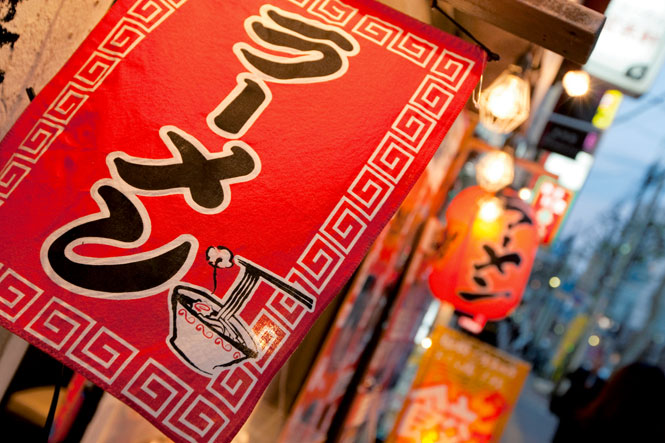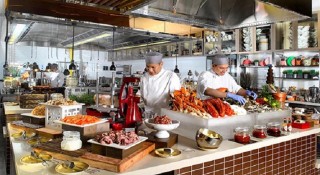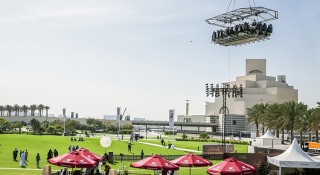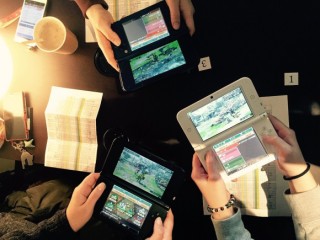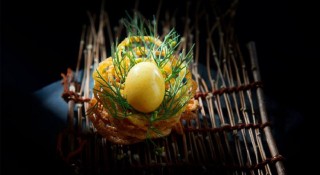Above: Basanova signature green-curry ramen.
In Tokyo, a noodle obsessive scours the city for the ultimate bowl of ramen
By Michael Booth
Photographs by Jeremy Sutton
I have come to Tokyo for a bowl of noodles. It’s a long way to go for a cheap lunch, granted, but since I began visiting Japan a decade ago, I’ve become obsessed by one local staple in particular: the salty-savory flavors and chewy-soft textures that lurk in a proper bowl of serious, seductive ramen.
I am not alone in my fixation. All of Japan is in the grip of a colossal, collective preoccupation with the country’s quintessential noodle soup. This is the so-called “ramen boom,” the subject of countless newspaper articles, magazine features, and TV shows, not to mention the guidebooks and blogs that contribute to the ceaseless chatter on what you would think was a relatively limited topic. Tokyo alone sees a new noodle bar open every day. Ramen may be Chinese in origin, but the Japanese have made it their own, at times elevating it to cult status; the improbable hero of a recent manga is a cat who runs a ramen shop.
Within minutes of checking in, I left my hotel, wild-eyed and desperate for ramen, any ramen. The first place I came across was a dingy, greasy hole-in-the-wall with all the charm of an auto shop. Here, I bought a token from the machine at the door, handed it to the chef, and sat expectantly at the counter. I had ordered a tonkotsu (pork bone) ramen, one of the four main categories of ramen—the others are soy, salt, and miso—that together head an almost infinitely diverse ramen family tree. As with many of the most memorable culinary flavors (think well-hung game or the more pungent French cheeses), a proper tonkotsu should taste faintly of the barnyard. This one, disappointingly, was just downright funky.
My second bowl, an hour or so later, was at Mist, an upscale ramen restaurant on the top floor of the Omotesando Hills mall. Inside, all was moody lighting and glittery stainless steel. I chose a miso ramen that, at 1,400 yen (about US$17), was double the price of my first. It was an improvement, but didn’t make my hair stand on end as some ramen can.
Clearly, with around 4,000 ramen shops in Tokyo alone (and 80,000 across Japan), I needed guidance. And so that evening, I met up with Rickmond Wong at the Shin-Daita train station in western Tokyo. Based in Los Angeles, Rickmond, in his mid-30s, is the author of Rameniac.com, one of the handful of English-language ramen blogs that I follow avidly. He is also a self-employed Web designer, a job which, he explained as we walked to a nearby noodle joint, allows him to travel as often as possible to Japan to indulge his passion for ramen.
We were heading for Basanova, a ramen restaurant owned by a chef from Fukuoka who had recently handed over the reins to Keizo Shimamoto, a Japanese-American, also originally from L.A. Keizo, wearing a back-to-front baseball cap and a little chin beard, was busy studying the viscosity of his pork broth, holding a sample of the soup up to the light in a refractor, a common tool of the modern ramen chef. “I’m looking for a rating of between five and 10,” he explained. “Beyond 10 and it gets too thick, more like a sauce.” Before moving from L.A. to Tokyo in 2009, Keizo traveled the length of Japan, eating dozens of bowls of ramen in 21 cities over the course of a month. “I probably still eat at least two bowls a day,” he said.
Basanova’s signature green-curry ramen was vibrant and frisky. As the last guest left, Keizo invited me into his kitchen. I spent a good hour sticking my nose in the stockpots (which consume more than 20 kilos of pork bones and half as many pig’s heads every three days), sniffing the roast pork and trying to decipher the ingredients of the tare.
The tare, or foundation sauce, is the soul of a bowl of ramen. Usually soy sauce– based, it might also feature the cooking juices from the pork, as well as sake, sugar, mirin, and dashi, plus ginger, garlic, onion oil, and, well, anything else the chef’s whim dictates. “Is this the most important element of ramen?” I asked Keizo of his dark and syrupy potion. “Kind of,” he replied. “But really great ramen is about a balance between the broth, the noodles, the tare, and the topping.”
The next day, Keizo and Rickmond invited me to tag along on one of their ramen expeditions, along with another American noodle blogger, Nate Shockey (of Ramenate!). A 27-year-old Ph.D. student at Columbia University, Nate had been researching modern Japanese literature in Tokyo for a year and a half. Fluent in written and spoken Japanese, he was considered the ramen scholar of the three.
Aside from the risk to their health of indulging almost daily in what, for all its myriad charms, is a fatty, salty dish, all have made quite alarming sacrifices to follow their ramen passion. Rickmond has a Japanese wife back in L.A. and must spend a fortune on airfares (“I am actually thinking of moving here so that I don’t feel I have to eat ramen all the time,” he jokes); Nick, as well as being Jewish (he doesn’t eat the slices of roast pork), has been a fervent vegetarian from the age of 10; and Keizo left a career in computer programming and broke up with his girlfriend of seven years to move to Japan and train as a ramen chef.
Our first stop was Tetsu, a nine-seat tsukemen or “dipping ramen” shop, where the noodles are served separately from the soup—a scorching-hot orb of iron being added midway through the meal to reheat your broth. “I’m not a big tsukemen fan, but that was impressive,” Keizo said. It was indeed: rich, hearty, and with impeccable (if alarmingly fat) noodles.
Next was Harukiya, a 60-year-old establishment in the Ogikubo neighborhood. Harukiya is said to have served Tokyo’s first shoyu (soy) ramen, which is now the city’s trademark style. But first we had to pass the gatekeeper, the mistress of the restaurant who, seeing our cameras, grilled us for 10 minutes on our intentions. Nate stepped in with his immaculate, courtly Japanese to placate the woman whose soup, I have to admit, was mighty fine—clear, simple, and clean-tasting. “Have you noticed it’s not steaming?” Nate asked. A finger-thick layer of oil was locking in the heat; ramen is invariably served nuclear hot, which is why the Japanese slurp it with such gusto. “For me, this is the platonic ideal of ramen,” he continued, holding some of the noodles up with reverence. They glistened in the light. “If you look closely you can see my soul in this bowl,” Keizo added with a sigh.
Talk turned to the wilder reaches of ramen culture, of a restaurant where they dump a scoop of ice cream in the middle of the soup, for instance; and of another, Arirang, which shuns publicity, refuses to give its address, and won’t serve you if you fail to order in the correct manner. There are places where the noodles are made with charcoal, or where things like coffee and even peanut butter are added to the broth. Keizo and Nate had recently been to a shop whose toppings included shark cartilage and sake lees. “And there’s a restaurant in Yonegawa where they serve bear-paw ramen,” Keizo said. “You have to order it three days in advance, so the owner can go out and shoot the bear.” I winced. According to Nate, curry ramen was this week’s trend. Before that, it was burnt-miso ramen. “I’m a fan of the Iberian ham ramen,” Rickmond offered. All had recently tried vegetarian or vegan versions, and predicted that organic ramen would be the next big thing.
In the meantime, we contented ourselves with Nidaime Keisuke, a modish place in student-centric Takadanobaba run by a French-trained chef. Keisuke is a rising star of Japanese ramen, championed by critics like Hideyuki Ishigami—“the man with the golden tongue”—and chef Sanu Minoru, whose every pronouncement on noodle texture is awaited with bated breath by legions of ramen aficionados. The soup was based on a shrimp stock, but it left me a little underwhelmed. “Not bad, but I wouldn’t come back, and that’s the real test for me,” agreed Keizo.
“In one sense you are always getting the same thing when you eat ramen,” Nate admitted at our fourth and final restaurant, the nearby fish-soup shop Watanabe, highly rated on the Japanese language–only Supleks ramen-ranking website (ramendb.supleks.jp). “But at the same time it is endlessly different. The pleasure for me is seeing what each place does with it.”
Added Keizo, “Ramen takes on the character of the people and ingredients around it, like in Kyushu they have more pork; up in Sapporo they use butter and corn. Whatever grows in the region, they use it in ramen.”
I was planning to venture forth on my own ramen quest in the following days and wanted to know how to spot a good restaurant. “It’s always a bad sign if they have cheap prices; don’t pay less than 400 yen a bowl,” suggested Rickmond.
“There doesn’t have to be a queue—places can get so hyped by the critics, which distorts things,” Nate said. “But they should always have a good crowd of customers. When in doubt, ask a cop. They usually know the good local places.” The next day, I stood in line for over an hour at Tokyo Station’s Ramen Street—a long subterranean hall featuring four outlets of popular ramen chains—to eat at Rokurinsha, revered for its dipping noodles (verdict: Oh. My. God.) Then, along with a number of pasty, portly men, I spent another hour queuing around the building that houses Ramen Jiro, a grimy, hard-bitten noodlery famed for its mammoth bowls of “rustic” ramen, piled high with cabbage and the saltiest, fattiest pork. The chef at Jiro is among a number of gruff, scarred ramen masters that have ascended to quasi-diety status, respected and feared like the feudal warriors of yore (albeit with their own pot-noodle ranges), but I left, having only half-finished his bowl.
In the end, I found my ultimate ramen by myself, wandering the seedy backstreets of Ikebukuro in northwest Tokyo. It was a gyouki (seafood) ramen at a branch of an artisanal ramen chain called Ganko, with its trademark pork bone hanging outside. The chef, Luis Doi, was unusually talkative for a man of his trade, and the spitting image of The Karate Kid’s Mr. Miyagi. His katsuobushi (smoked skipjack tuna) and niboshi (dried baby sardines) broth, with its clean, tangy taste of the sea, still gives me goose bumps when I think of it.
THE DETAILS:
Tokyo’s Top Ramen Shops
- Basanova, 1-4-18 Hanegi, Setagaya-ku; 81-3/3327-4649
- Ganko, 1-14 Higashi-Ikebukuro, Toshima-ku; no telephone
- Harukiya, 1-4-6 Kamiogi, Suginami-ku; 81-3/3391-4868
- Nidaime Keisuke, 2-14-3 Takadanobaba, Shinjuku; 81-3/5814-5131
- Ramen Jiro, various locations; see http://ramentokyo.com/2007/06 /ramen-jiro.html for addresses
- Rokurinsha, Tokyo Ramen Street, Tokyo Station; 81-3/ 5434-0566
- Tetsu, 4-1-14 Sendagi, Bunkyo-ku; 81-3/3827-6272
- Watanabe, 2-1-4 Takadanobaba, Shinjuku; 81-3/3209-5615
The Blogs
Ramenate.com, Rameniac.com, and RamenTokyo.com are handy, regularly updated resources, as is Keizo Shimamoto’s GoRamen.com. The best site for finding ramen shops in or outside Tokyo is the Supleks ramen database, which is written entirely in Japanese. For help navigating it, check out RamenTokyo’s instructions at http://ramentokyo.com/2009/05/supleks-ramen-database.html
Originally appeared in the December 2010/January 2011 print issue of DestinAsian magazine (“Food Stuff – Ramen Mania”)

